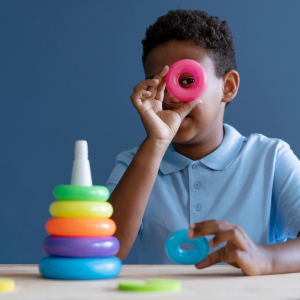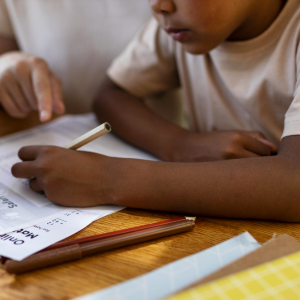
Schools do an important job. They teach our children how to read, write, solve math problems, and understand the world around them. And for the most part, they do it well. But as parents, we quickly learn that being “book smart” isn’t the same as being life smart.
You might have a child who is great at spelling or aces their science tests but still struggles with managing their emotions. That is not a sign that something’s wrong. It just means there are some lessons children won’t get from textbooks or classrooms.
These are the skills that shape how they show up in the world, how they treat others, handle challenges, take responsibility, and grow into confident, capable adults. The truth is, school can't cover everything. And that is where you come in.
As a parent or guardian, you are in the best position to teach your child some of life’s most important lessons, not through lectures or pressure, but through everyday conversations, small choices, and lots of encouragement.
Let us look at five key skills that most children don’t learn in school and how you can help them grow at home.
1. Emotional Awareness and Regulation
Children have big feelings, and they don’t always know what to do with them. That is why helping them understand and manage their emotions is such a valuable skill.
Start by naming feelings when you see them: “You look frustrated; is it because the game isn’t going your way?” This helps children learn the words for what they are feeling and makes it okay to talk about it.
You can also model calm behavior when you are upset. Instead of snapping or shutting down, say something like, “I’m feeling very upset right now, so I’m going to take a minute to breathe so I don’t say something I will regret later.”
These small moments teach children that emotions are normal, and there are healthy ways to handle them, not just for now, but for life.
2. Communication and Active Listening
Being able to talk clearly and listen well is a skill that helps in every part of life, with friends, family, teachers, and later on, coworkers. But it is not always taught directly in school.
At home, you can help your child practice this by simply having real conversations. Ask about their opinions. Let them explain things, even if it takes a while. Show them what good listening looks like: putting down your phone, making eye contact, and not interrupting.
You can also play simple games like “Say it another way” to help them find better ways to express themselves. For example, if they say, “I hate this,” help them rephrase it: “I’m frustrated because this is hard.”
Over time, these small efforts build strong communication skills that will serve them for life.
3. Decision-Making and Problem-Solving
Children make decisions every day, from what to wear to how to handle a tough situation with a friend. But they often don’t get to practice making real choices or thinking through problems step by step.
You can help by involving them in everyday decisions. Let them help plan a weekend outing or choose between two options for dinner. Talk through the pros and cons together, and let them experience the results of their choices, even if things don’t go perfectly.
When a problem comes up, instead of jumping in to fix it, ask, “What do you think we can do?” This gives them a chance to think things through and builds confidence in their ability to figure things out.
It is not about having all the answers; it is about learning to think clearly and try, even when things feel tricky.
4. Money Basics
Many children grow up knowing how to solve math problems but have no idea how to manage money. It is not their fault; schools don’t usually teach real-world money skills like budgeting, saving, or spending wisely.
You don’t need to give a full lecture to teach this. Start with simple things: give them a small allowance and guide them on how to divide it, some to spend, some to save, maybe even some to give.
Talk openly about everyday money choices. Explain why you are choosing one item over another at the store or how you plan for monthly bills. Let them help with a shopping list and stay within a budget.
These real-life lessons add up, and they help your child learn that money is a tool and how they use it matters.
5. How to Handle Failure and Keep Going
School often rewards getting the right answer, which is good. But life is full of mistakes, setbacks, and trying again. That is why learning how to handle failure is one of the most important skills a child can have.
Let your child know it is okay to mess up. Share stories of your own failures and what you learned from them. When they fall short, whether it is a test, a game, or a project, focus on effort and growth: “I saw how hard you worked on that. What do you think you’d do differently next time?”
When children understand that failure isn’t the end of the world, it is just part of learning, they are more likely to bounce back and keep trying.
That is resilience, and it is a skill they will use their whole life.
Help Your Child Thrive Beyond the Classroom
School teaches a lot, but it doesn’t cover everything, and that is where we come in.
Today’s children are growing up in a fast-paced world filled with pressure, uncertainty, and constant change. Without the right life skills, many struggle with confidence, decision-making, and relationships, even if they are doing well in school.
Enroll your child (ages 6–18) in our mentoring academy and give them the tools to thrive in school, at home, and in life.

It starts subtly sometimes. Maybe your child used to enjoy school, and now they seem frustrated every afternoon. Or the teacher mentions missing assignments, or you have noticed their grades quietly slipping. Maybe there are tears over homework or complete avoidance of it altogether.
Whatever the signs, one thing is clear: your child is struggling, and you are not sure what to do.
School challenges can shake everyone’s confidence; your child’s and yours. It is easy to spiral into worry or start blaming others. But that is not the solution.
In today’s post, I will walk you through simple, thoughtful steps you can take to understand what is really going on and how to help your child move forward with confidence.
1. Pause and Take a Breath
When you notice your child struggling, it is natural to feel worried, frustrated, or even guilty. Maybe you start asking yourself, "Am I doing enough? Did I miss something? What does this say about me as a parent?”
All those feelings are normal. But acting from a place of panic doesn’t help your child or you. Children are incredibly sensitive to our emotions, even when we think we are hiding them. If they sense our stress, it can add pressure to what they are already feeling.
So before you have a talk, write an email to the teacher, or make a plan, pause. Take a deep breath. Remind yourself that your child’s struggle is not a sign of failure; it is an opportunity to grow, with your support.
2. Talk (and Listen) to Your Child
Once you have taken a breath yourself, the next step is gently opening up a conversation with your child. Not a lecture. Just a quiet check-in that lets them know you are on their side.
You might say something like,
“Hey, I have noticed school seems a bit tougher lately. Want to talk about it?”
Or
“Is there anything that has been bothering you about school?”
Keep your tone relaxed and curious. The goal is to make them feel safe, not like they are in trouble.
They might not open up right away, especially if they are embarrassed or frustrated. That is okay. Try not to rush it. Let the conversation unfold over time.
Also pay attention to what they are not saying. Are they suddenly avoiding homework? Are they always “tired” when it is time to study? These little clues can tell you just as much as their words.
And if they do share something, like they don’t understand a subject, feel behind, or are having trouble with classmates, resist the urge to fix it immediately. First, just listen and thank them for telling you. Feeling heard is powerful. It lays the groundwork for every step that comes next.
3. Identify What’s Really Going On
“Struggling in school” can mean a lot of different things; sometimes it is about academics, but it can also be emotional, social, or even physical.
Here are a few things to look out for:
- Is the struggle subject-specific? Maybe they are doing fine in reading but falling behind in math. Or they love science but freeze up during writing assignments.
- Is something happening with friends? Social challenges can spill over into school performance. If they feel excluded or bullied, it can be hard to focus or feel safe.
- Are there emotional or focus-related signs? If they are feeling anxious, overwhelmed, or easily distracted, school can quickly become frustrating.
- Are there any changes at home? A big move, family stress, or even a change in routine can throw things off more than we realize.
It might help to jot down patterns you notice over a week or two. What times of day are hardest? What assignments get avoided? Who are they spending time with?
Getting clear on the root of the struggle helps you respond in the right way. And if you are unsure, don’t hesitate to ask the teacher for their perspective.
4. Connect with the Teacher (Not Just When There is a Problem)
Once you have had a conversation with your child and gotten a clearer picture of what might be going on, it is time to loop in the teacher. This step often gets skipped or delayed, but teachers are your best teammates here. They see your child in a different setting, and they often notice things you might not.
Remember you are not blaming or demanding answers; you are starting a conversation. Teachers usually appreciate this kind of approach because it shows you are engaged and respectful of their role.
During the conversation (whether by email, phone, or in person), you might ask:
- How has my child been doing in class lately?
- Are there specific subjects or activities where they seem more challenged?
- Have you noticed any changes in their focus, mood, or behavior?
You can also share anything you have observed at home. When parents and teachers work together, it gives the child a consistent support system, and that can make a huge difference.
Even if you have spoken with the teacher before, it is okay to check in again. Learning is a journey, and your child’s needs can shift along the way.
5. Explore Support Options Early
If your child is struggling, early support is key. Sometimes, a small adjustment is all they need: a bit of one-on-one time with the teacher, extra help with homework, or clearer routines at home. Other times, they might need something more structured, like tutoring or an assessment.
Outside of school, there are also resources like;
- Lesson teacher (many are subject-specific)
- Educational apps or games that make practice feel fun
- Peer study groups
- Counseling if emotional challenges are playing a role
The main thing? Don’t wait for things to feel “serious” before getting help. Early support builds confidence and gives your child tools to cope before frustration takes over.
6. Build Healthy Habits at Home
Sometimes the school struggle isn’t just about school. It is about what is happening around it. A few simple routines at home can go a long way in helping your child feel more in control, focused, and calm.
Start with the basics:
- Sleep: Tired children have a harder time focusing, remembering things, and managing emotions. Aim for a regular bedtime and try to keep screens out of the bedroom, especially before sleep.
- Screen Time: Too much screen time (especially before homework) can make it harder for children to settle down and focus. Create a family rule like “homework first, screens later,” or use a timer to set limits.
- Homework Space: Find a quiet, clutter-free spot where your child can work. It doesn’t have to be fancy; a small desk or kitchen table with a basket of supplies can work just fine.
- Short Breaks: Encourage work in chunks, say, 25 minutes of homework followed by a 5-minute stretch or snack break. This helps keep energy up and frustration down.
- Meal Times and Movement: Regular meals and some kind of daily movement (a walk, playtime, sports) help with focus and mood.
These small, steady routines build a sense of calm and predictability, especially helpful when school feels hard.
7. Celebrate Effort, Not Just Results
When your child is struggling, it is easy to zero in on the grades or missed assignments. But what they need most is encouragement for showing up and trying, even if the results are not perfect (yet).
Praise things like:
- “I noticed you kept going even when the homework felt hard.”
- “You asked for help; that was brave.”
- “You focused really well today; I’m proud of you.”
These kinds of comments help your child connect success with effort and growth, not just the final mark. It teaches them that struggling doesn’t mean failing; it means learning.
If they improve in even the smallest way: a better score on a quiz, completing homework without being reminded, or getting through a subject without tears. Celebrate that win. Track their progress together. Make a little chart. Let them see how their efforts are adding up.
This builds confidence and resilience, which are just as important as any report card.
You are Not Failing
If your child is struggling in school, it doesn’t mean you failed as a parent. It is actually the opposite. The fact that you noticed the struggle and chose to step in with care and intention is one of the most important things you can do as a parent.
While it might feel slow or messy at times, progress is still happening, especially when they have your steady support beside them.
Remember, this is not about finding a quick fix. It is about walking through this season together. Your calm presence, your willingness to ask questions, and your ability to remind them of their strengths can all help turn things around.

You pick your child up from school, smile, and ask, “How was your day?”
They shrug. “Fine.”
You try again. “Anything interesting happen?”
“Not really.”
And just like that, the conversation ends.
Sound familiar?
We want to be there for our children. We want to know if they are happy, worried, hurt, or just excited about something they learned. But sometimes it feels like there is a wall we can’t get past, and the more we push, the quieter they become.
As children move into the pre-teen and teen years, it is common for them to turn more toward their friends: both online and in person, when they are feeling things deeply or just need to talk. It can be tough for parents to watch.
This shift isn’t a rejection. It is part of growing up. Friendships take on a new weight in these years. Talking to someone their own age can feel easier, safer, or less complicated. Friends might not “fix” things or give advice the way adults do, they just listen and say, “me too.” That kind of peer support can feel comforting when you are figuring out who you are.
Still, it doesn’t mean you are out of the picture. In fact, your role is more important than ever. Children still want (and need) a strong connection with you. They just may need you to meet them a little differently than before.
In this post, we will explore simple, practical ways to create the kind of relationship where your child feels comfortable opening up not just to their friends, but to you too.
1. Start with You: Create the Right Environment
Children are always watching us, even when we think they are not. One of the best ways to help your child feel comfortable opening up is to show them what that looks like. Talk to them about your own day, not the stressful stuff, just small things like, “I had a funny moment at work today,” or “I felt a little off this morning, but my coffee helped.” It shows them that sharing is normal and doesn't have to be a big deal.
2. Timing Is Everything
Trying to have a heart-to-heart right after school or when your child is upset usually doesn’t go well. Most children need a little space before they are ready to talk. And honestly, don’t we all?
Look for natural, low-pressure moments to connect, like when you are driving together, eating dinner, or doing something side by side. These times feel more relaxed and make it easier for children to open up without feeling like they are being put on the spot.
And if they are not in the mood to talk? That is okay too. Let them know you are around and ready to listen when they are.
3. Ask Better Questions
Sometimes it is not what you ask, but how you ask it. “How was your day?” usually gets a “fine” because it is too broad. Try asking something more specific, like
- “What was the best part of your day?”
- “Did anything surprise you today?”
- “Who did you hang out with at lunch?”
These kinds of questions feel more natural and give your child something real to answer. If they still don’t say much, don’t worry. Keep asking gently, and over time, they will likely start to share more.
4. Listen More, Fix Less
When your child does open up, your first instinct might be to jump in with advice or try to fix the problem. That is totally normal, you just want to help. However sometimes, what children really need is for us to just listen.
Try to stay quiet and let them talk. Show that you are listening by nodding or saying things like, “That sounds tough,” or “Thanks for telling me.” If they ask for advice, you can offer it. But often, they just want to feel heard and understood.
Sometimes the best way to help is simply being there with your full attention.
5. Build Connection Daily
You don’t need a long conversation every day to stay close with your child. Just a few minutes of one-on-one time can make a big difference. It could be playing a quick game, reading together, or just sitting and chatting while you fold laundry.
Let them pick the activity sometimes, and follow their lead. When children feel connected to us in small ways every day, they are more likely to come to us with the big stuff when it matters.
It is those everyday moments that quietly build trust.
6. Respect Their Privacy
It is hard not to press when your child doesn’t want to talk, especially if you feel something’s going on. But pushing too hard can make them pull away more.
Let them know you are there whenever they are ready to talk, no pressure. You can say something like, “I’m here if you ever want to chat,” and then just leave it at that. Giving them space shows respect, and that respect helps build trust over time.
Remember, just because they are quiet now doesn’t mean they won’t open up later.
7. Watch Your Reactions
How you respond when your child finally does open up really matters. If you get upset, overreact, or criticize them, they may think twice before coming to you again.
Even if what they say surprises or worries you, try to stay calm. Take a breath, listen fully, and thank them for telling you. You can deal with the details later. The most important thing in the moment is making them feel safe and supported.
8. Know When to Get Help
If your child seems very withdrawn, unusually angry, anxious, or just not like themselves for a long stretch, it might be time to get a little extra help. Talking to a school counselor, pediatrician, or expert can be a great next step.
And it helps to remind your child that talking to someone doesn’t mean something is “wrong” with them. It just means they have another trusted person to talk to when things feel heavy.
Sometimes support from outside the family is exactly what they need, and that is okay.
Keep Showing Up
Getting your child to open up isn’t always easy, and that is okay. Some days they will talk, and other days they might not say much at all. What matters most is that they know you are there when they are ready.
Keep the door open with small moments of connection. You don’t have to have all the right words. Just being present, patient, and kind goes a long way. Over time, those small efforts build trust and this is what helps children open up.



